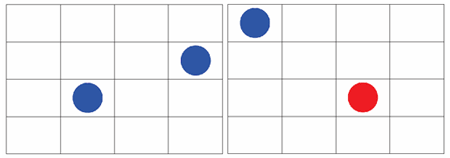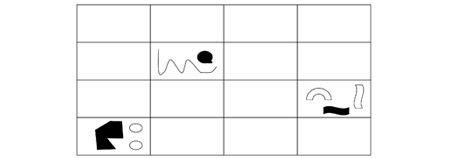| On the Cursory Cognitive Condition Examination, Detail xi (Inhibition), the examiner is supposed to administer the sample detail, and and so tell the examinee to do the same thing for the actual item. After I demonstrate the entire row and tell them I desire them to do the "aforementioned thing," should the examinee redo the first row that I just showed them and continue on, or should they begin with Line 2 (and keep from where I left off)? |
| The examinee begins back at the commencement item of the first row. The maximum number of points for this detail is 24, reflecting the 24 shapes in the detail. |
| The verbal load on many of the Visual Memory and Visual Working Memory subtest instructions seems substantial. We are concerned that the difficulties a client may feel in agreement the directions may deject the results of these Visual Memory subtests. |
| Working memory is presented for a visual modality in WMS–Four as the Visual Working Retention Index. This index is derived from the sum of scaled scores for Spatial Addition and Symbol Span. Construction of stimuli used for these subtests purposely minimized the caste to which the stimuli could exist verbalized and, subsequently, invoking the verbal working memory system. VWMI correlates at .53 with Verbal Comprehension, like to the correlation with Processing Speed (r = .51), merely less than Perceptual Reasoning (r = .67) and Working Memory (r = .62). There is no evidence of a negative bear on to VWMI relative to other skill areas in the clinical samples with significant language deficits. If you lot have a business organisation about a specific client not understanding the instructions, it is allowable to repeat the examples and directions until they understand the task. |
| Please explain why the Designs task is improve than the Faces chore. Too the fact that it is more than hard to verbally mediate the Designs task, and that in that location may be other confounds on a face memory task, it seems that there are significant executive performance demands with Designs and it appears to be an incredibly hard task! (i.due east., there are lots of distracters that have many similarities to the target stimuli; consequently, establishing relevant from irrelevant may be difficult). |
| Face memory is a specific type of memory part that is often impaired in clinical groups with known social perception deficits (e.m., Schizophrenia, Autism) and is sometimes sensitive to right–left differences in temporal lobe epilepsy. The WMS–3 Faces subtest has a relatively high guess rate that lowers its reliability relative to other memory tasks. Faces by and large has depression communality with other memory measures. The Faces subtest is useful for specific types of retentivity evaluations, but results may non operate as expected as a general indicator of visual memory. The Designs subtest was developed specifically to measure spatial and item segments of memory operation, as well every bit the integration of these in recall. This follows the segmentation of the visual system that has a dorsal stream, which processes primarily visual-spatial aspects of memory and the ventral stream that processes visual details with the purpose of attaching exact labels where possible. Well-nigh visual retentivity measures do non enable the examiner to differentiate the nature of the visual memory problem and, therefore, makes estimation more than hard. Every bit far as executive functioning or attention to detail is concerned, the Designs subtest is comparable to most visual retention measures in this respect. For example, in the Faces subtest, the distracter faces are similar to one of the target faces. Family Pictures (WMS–Three) and Picture Retention (WRAML–Ii) require attention to details, also as visual scanning and search abilities. Tests such as the Rey-Complex Figure are used to measure executive performance (see Bernstein & Waber, 1996) and visual memory. The Designs subtest requires fewer demands on executive functioning than other commonly used visual memory measures. |
| What are Dissimilarity Scores and how do I use them? |
| Contrast scores enable you to sectionalisation overlapping variance between related abilities or a forerunner ability of the construct of interest. In the contrast score name, the first score is the control variable and the second score is the dependent mensurate. For example, in the Logical Retention Immediate Think vs. Delayed Retrieve contrast scaled score, the Logical Memory I scaled score is the control variable and the Logical Memory II scaled score is the dependent measure out. Contrast scaled scores are scaled on a hateful of 10 and a standard deviation of 3, just should non be considered a replacement for the standard age-adjusted scaled scores. Contrast scores supplement standard age-adjusted scores and answer specific questions regarding an examinee's performance. They should not be reported or interpreted equally being the examinee'due south performance relative to same-age peers. Standing with the Logical Memory case, the standard historic period-adapted scaled score answers the question, "Is the examinee's Logical Memory Delayed Call up dumb?" while the contrast score answers the question, "Is the examinee'due south Logical Memory Delayed Recall dumb given their initial encoding of the stories during Immediate Call up?" This contrast score reflects the examinee's performance during delayed recall controlling for performance during firsthand recall. In other words, the Logical Retentivity Two scaled score is existence adjusted for the Logical Memory I scaled score. Using the contrast score to supplement the information provided by the standard historic period-adjusted score, the estimation of the 2 scores may be, "Customer A's Logical Memory Delayed Retrieve is in the Borderline range of functioning in comparison to aforementioned age peers. However, given the amount of material initially encoded during Immediate Recall, Customer A's performance is inside the Low Average range of operation." Contrast scores between 8 and 12 indicate that performance on the command and dependent variables is not significantly dissimilar. For example, the examinee's delayed recall is what you would expect given their initial encoding of the stories. Contrast scores greater than 12 suggest, for example, that delayed recall is improve than expected given their initial encoding of the stories. Contrast scores less than 8 suggest delayed recall is worse than expected given the examinee'due south initial encoding of the stories. For further case studies using Contrast scores, see the Contrast Scaled Scores presentation on the WMS–IV website. |
| Which medications were listed as acceptable and how did you decide they were? What medications were examinees taking, e.yard., Aricept for Alzheimer's? |
| The exclusion and inclusion criteria in the WMS–IV Technical and Interpretive Manual Table 2.1 and Appendix D, respectively, list medication guidelines used in the normative sample and special groups. Medications were designated as acceptable, provisionally acceptable, or excluded during standardization example collection. A key factor in deciding the acceptability of a medication was its affect on the examinee'south functioning during test administration. The Neppe Psychological Symptom Questionnaire (NPSQ) and NPSQ Acceptance Criteria Checklist were used in the initial screening to gather information on medication blazon, reason for taking it, dosage/frequency, and whatever side effects/symptoms within 2 days prior to testing. Cases that involved excluded medications or did non run into NPSQ criteria were excluded from the written report. The WMS–IV development team fabricated decisions on a instance-by-case ground if medications were not included on one of the three lists or were excluded for other reasons (e.g., off-label medication use). A diverseness of medications were beingness taken past individuals in the normative and clinical groups. In all circumstances, allowed medications were not suspected of interfering with an examinee's examination performance. Examiners reported on whether they felt medication utilise affected examinee test performance. |
| Do you accept more than information about the clinical groups reported in the WMS–4 (east.m., TBI, ALZ)? |
| The WMS–IV Technical and Interpretive Manual lists the Exclusion criteria (Table 2.1) and the general and special group-specific inclusion criteria (Appendix D) reported. Where appropriate, DSM-4-TR criteria and other well-established guidelines for diagnostic purposes were followed. When possible, data regarding premorbid functioning was gathered. |
| Where can I get training on administering the WMS–IV? |
| A brief training video has been produced past Pearson and will be available to all WMS–IV users. Y'all may also contact our customer service line for specific questions about the WMS–IV, including requests for webinars or site grooming sessions. |
| In the past, the Wechsler Memory Test came with a cardboard easel so that the instruction panels are non visible to the examinee. The WMS–IV does not. What did the developers consider when they changed the format of the stimulus books? |
| We received many customer complaints most the immovability of the WMS–Iii Stimulus Books. Using a flat Stimulus Book should improve the lifespan of the materials and improve administration. Information technology's easier to administer Symbol Span, Designs Recognition, and Visual Reproduction with a apartment Stimulus Book considering the examinee is required to point to a response. The flat presentation too reduces the likelihood that the examiner will demand to inquire the examinee for a exact response. For the Spatial Improver and Designs tasks, a flat Stimulus Book presents the same visual plane as the examinee's responses, reducing the confounding spatial resolution issues between the presentation and response mode. The WMS–IV was normed using a flat Stimulus Book. If you lot prop up the book, it is considered a nonstandardized assistants and would peradventure invalidate exam results. To facilitate the flat orientation, all correct responses accept been moved to the Tape Forms. |
| My office only inverse our operating system from XP to VistA. We were told by a Pearson representative that at that place is no upgrade for the CVLT–Two. Is that true? |
| CVLT–II was recently certified to piece of work on Vista operating systems, both 32 flake and 64 bit OS, so at that place should exist no issue. An update is non required to work with WMS–IV. |
| Why is in that location no opportunity to repeat the Joe Garcia story? Many clinicians like to evaluate if repeating the story benefits the examinee and if there is a difference in narrative think for immediate and delayed recall for each of the stories. |
| The repetition of Joe Garcia was dropped considering at that place is already a learning job on Verbal Paired Associates. If yous repeat the Joe Garcia story, y'all cannot compare how well someone performs on delayed recall when they have the repetition versus when they do not. It was necessary to echo a story for the older age group because at that place would be bereft floor if information technology was non repeated. |
| Why is the WMS–IV devoid of human figures? |
| The decision was made to omit the Faces subtest from WMS–IV and include it in the Advanced Clinical Solutions for WAIS-Four and WMS–Iv Social Cognition battery. The Faces subtest measures a very specific memory process that is not necessarily the best measure for routine neuropsychological evaluations. If you are assessing individuals with Schizophrenia or an Autism Spectrum disorder, you may find the ACS Social Perception subtest very benign. The subtest provides valuable data nearly facial processing without the retention component If you prefer to employ Family unit Pictures or Faces, you lot may continue to employ the WMS–Iii version. Remember that the norms only get softer, so if an individual is mildly impaired, the older norms may not detect the more subtle retentivity damage. |
| The Spatial Addition job seems as if it would be also confusing for impaired or elderly patients. If you are testing patients with Alzheimer's disease, tin they understand the task and get a scoreable response? |
| The Spatial Addition chore is for examinees, ages 16–69 years, who are taking the Adult Bombardment. Many of the examinees classified every bit Probable Dementia in the Alzheimer's Type group were administered the Older Adult Battery and did non have the opportunity to take Spatial Addition. The Balmy Cognitive Impairment group did non accept difficulty understanding the job and producing scoreable responses. If an examinee is younger than historic period 65 and has difficulty understanding the task due to severe dementia, they most probable volition take difficulty throughout much of the evaluation. In the moderate and balmy intellectually disabled groups, the VWMI, which Spatial Addition contributes to, was consistent with their overall working retention abilities and General Power. |
| Why was Digit Span dropped from WMS–4? |
| One of the WMS–IV development goals was to eliminate content that overlaps with the WAIS–Four, which affected a few subtests. Dropping Digit Span ensured that the same construct (i.e., working retentiveness) was non measured in the same modality in both instruments and ensured that disparate working memory scores between the 2 batteries would not occur. WMS–III and WAIS–III had disparate working retentiveness scores because different subtests contributed to the Working Retentivity Indexes. WAIS-III and WMS–III Indexes included Letter-Number Sequencing, but Spatial Span was the second contributing subtest in WMS–III with Digit Bridge considered only as an optional subtest. By dropping Digit Bridge, the WMS–IV has a strong focus on components of visual working retentivity and the WAIS-Four focuses on auditory working memory. |
| Why was Letter-Number Sequencing dropped from WMS–Iv? |
| The elimination of Letter of the alphabet-Number Sequencing ensured that the same construct (i.e., working memory) was not measured in the same modality in both instruments. Both WAIS-III and WMS–Iii included Letter-Number Sequencing in the Working Memory Index. The emptying of Letter-Number Sequencing strengthens the focus of WMS–IV on components of visual working memory, while WAIS–IV focuses on auditory working retentiveness. |
| Why were the Mental Command, Data, and Orientation subtests dropped from WMS–IV? |
| These subtests were moved from the WMS–IV to the Brief Cerebral Status Exam (BCSE). Their usefulness in providing sensitivity and differentiation betwixt normal and clinical performance and as a brief screening of an individual's level of cerebral functioning was proven during standardization. The BCSE yielded similar or amend information than the MMSE and AQT. Each of these subtests was optional in the WMS–3 and client surveys revealed that they were rarely administered. |
| Why was Faces dropped from WMS–IV? |
| The Faces subtest was revised and is part of the Advanced Clinical Solutions for WAIS-Four and WMS–Iv. Faces is a specific retentiveness process that does not correlate well with other memory functions and has express sensitivity as a general visual memory tool. An examinee'due south performance on the Faces subtest provides important information nearly social cognition, because information technology measures face discrimination as well as recognition. |
| Why was Family Pictures dropped? |
| Family unit Pictures was dropped because it is not a true visual retentivity task, it is primarily a visual-verbal association task. For the nigh part, Family unit Pictures is a verbal measure out resulting in the WMS–Three Visual Memory Index not holding well together. The WMS–IV Visual Memory Index is a more than pure visual retention measure than the WMS–III. The Family Pictures subtest could be failed for a number of reasons including, naming difficulties, spatial retention issues, difficulties remembering visual details, impairments in visual-verbal association memory etc. The WMS–Iv visual memory subtests help differentiate performance on some aspects of these while minimizing the impact of verbal encoding. |
| Why was Spatial Bridge dropped? |
| Examiners expressed concerns well-nigh tracking and recording of examinee responses which contributed to the decision to drop Spatial Span from the WMS–4. One of the development goals for WMS–IV was to develop visual working memory tasks that crave mental manipulation of visual information which Spatial Span does not since neither the astern nor forrard status crave the examinee to operate on the information that have been shown. |
| Why was Word Listing dropped? |
| The Word List subtest was optional in WMS–III. The elimination of this subtest shortened the overall administration of the WMS–4 while the ability to substitute the CVLT-Two scores for the Auditory, Firsthand and Delayed Indexes was added to give examiners flexibility in the measures they wish to utilise including a type of word list task. |
| Why does WMS–Iv focus on Visual Working Memory with out Verbal Working Retentiveness? |
| A development goal for the WMS–Four was to avert overlapping modalities and constructs with the WAIS-IV. The working memory tasks in the WAIS-IV crave greater verbal need thus the WMS–4 working retentivity focuses on a visual modality. |
| I ofttimes use Demographically Adapted Norms, volition those be available and if so, when? |
| These types of adjusted norms will exist available through the ACS software late 2009. |
| I test low functioning individuals who appear to have difficulty completing the WMS–4 tasks. Is the WMS–4 advisable for this population? |
| The WMS–Four showed practiced clinical utility, reliability, and concurrent validity during standardization, peculiarly in clinical groups. Although individuals express difficulty with these subtests, even moderately impaired individuals were able to complete some of the items, peculiarly on Designs. The Designs subtest is perceived by many individuals to exist hard specifically because the stimuli are hard to verbalize. The language centers of the brain naturally want to proper name objects to ease encoding and thus invoke verbal retention processes to aid visual memory functioning. The Designs subtest has multiple items of varying difficulty later on it is not difficult for examinees to get some points. The examinee may demand to be encouraged to try fifty-fifty though it seems difficult. Interestingly, the intellectually disabled (mild and moderate) had some of their best scores on the Designs subtest. On Spatial Add-on nosotros did non see very many 0 scores during standardization so even very impaired people were completing the task correctly on early items, they just tended to discontinue earlier. |




0 Response to "How Many Years Do You Need to Wait to Take the Wms Again in Order for Results to Be Valid"
Post a Comment